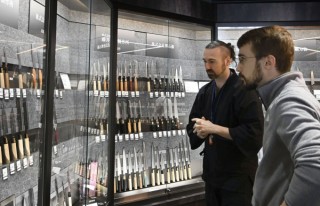Loading
Search
▼ Sakai Knives A Cut Above For Foreign Visitors To Japan
- Category:Other
The global popularity of blades forged in the western Japan city of Sakai is on the rise, with foreign tourists helping to boost sales of the city's native brand that is widely regarded as one of the country's top three traditional knives.
The Sakai Traditional Crafts Museum saw annual sales of its blades surpass 100 million yen ($660,000) for the first time in fiscal 2023 and expects another record this fiscal year, with foreign tourists from the United States, France and others making up half of the sales.
Sakai blades date back to Japan's Kofun period (from the third to seventh century), when blacksmiths gathered in the area to forge iron tools for tomb construction for the ruling class, according to the museum operated by the city.
One such ancient tomb is a keyhole-shaped mound administered by the Imperial Household Agency as the burial ground of Emperor Nintoku, now a UNESCO World Heritage site.
The industry began to flourish in the late 16th century when tobacco was introduced to Japan by Portugal and spurred the development of high-quality tobacco knives, leading to the endorsement by the Tokugawa shogunate that lasted until 1868.
Unlike mass-produced blades, Sakai blades are handmade by artisans that specialize in forging, sharpening and handle-making, with each step performed separately.
Today, Sakai knives continue to be crafted using traditional techniques passed down through generations and are widely used by chefs in Japan, the museum said.
"Foreign tourists are not just buying products -- they are buying stories," said Eric Chevallier, 35, a coordinator for overseas sales at the Sakai City Industrial Promotion Center.
Chevallier, a French national, said he sometimes spends hours explaining details of the knives while visitors handle and familiarize themselves with the blades.
"By knowing the history and how blades to be purchased are made, (tourists) will be able to imagine their background when using them in their home countries," he said.
Foreign tourists are said to frequently buy dozens of knives to bring home as souvenirs for family and friends, with those featuring wave-like patterns on the blade particularly popular.
According to the city, the value of the museum's knife sales rose from 20 million yen in fiscal 2021 during the COVID-19 pandemic to 80 million yen the following year, and 140 million yen in the most recent fiscal year.
"Our top priority is hospitality. We strive to carefully explain the background of each knife to every individual so they can use it for years to come," said the museum's director Misa Endo.
The Sakai Traditional Crafts Museum saw annual sales of its blades surpass 100 million yen ($660,000) for the first time in fiscal 2023 and expects another record this fiscal year, with foreign tourists from the United States, France and others making up half of the sales.
Sakai blades date back to Japan's Kofun period (from the third to seventh century), when blacksmiths gathered in the area to forge iron tools for tomb construction for the ruling class, according to the museum operated by the city.
One such ancient tomb is a keyhole-shaped mound administered by the Imperial Household Agency as the burial ground of Emperor Nintoku, now a UNESCO World Heritage site.
The industry began to flourish in the late 16th century when tobacco was introduced to Japan by Portugal and spurred the development of high-quality tobacco knives, leading to the endorsement by the Tokugawa shogunate that lasted until 1868.
Unlike mass-produced blades, Sakai blades are handmade by artisans that specialize in forging, sharpening and handle-making, with each step performed separately.
Today, Sakai knives continue to be crafted using traditional techniques passed down through generations and are widely used by chefs in Japan, the museum said.
"Foreign tourists are not just buying products -- they are buying stories," said Eric Chevallier, 35, a coordinator for overseas sales at the Sakai City Industrial Promotion Center.
Chevallier, a French national, said he sometimes spends hours explaining details of the knives while visitors handle and familiarize themselves with the blades.
"By knowing the history and how blades to be purchased are made, (tourists) will be able to imagine their background when using them in their home countries," he said.
Foreign tourists are said to frequently buy dozens of knives to bring home as souvenirs for family and friends, with those featuring wave-like patterns on the blade particularly popular.
According to the city, the value of the museum's knife sales rose from 20 million yen in fiscal 2021 during the COVID-19 pandemic to 80 million yen the following year, and 140 million yen in the most recent fiscal year.
"Our top priority is hospitality. We strive to carefully explain the background of each knife to every individual so they can use it for years to come," said the museum's director Misa Endo.
- February 9, 2025
- Comment (0)
- Trackback(0)


